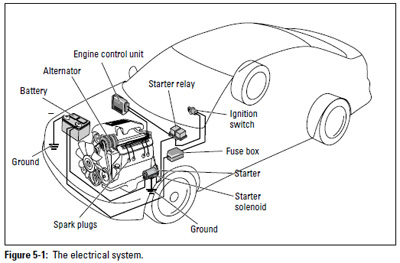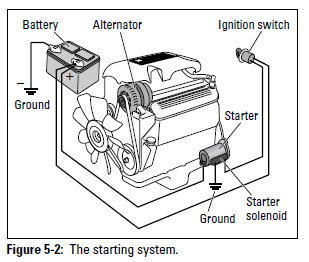Cranking is when the starter spins the engine. This is done by the starter motor engaging the engine and turning the crankshaft. Back in the very old days this was actually done by a person with a crank handle directly cranking the engine over by hand, hence the term "cranking". For the last 100 years, this is done by a starter motor.
Starting is a more general term to mean the engine has not reached a running state. Starting includes first cranking and then the engine generating combustion to run on its own without the starter. This requires fuel, spark, cranking, and a bunch of mechanical bits working in harmony.
The rest of this discussion is just about cranking. The 2 most common components at the root cause of failing to crank are the battery and the starter.


Here is a good article introducing some of these basic components: http://www.military.com/off-duty/autos/auto-repair-electrical-system-tips.html
There are interlocks and security systems that may prevent the vehicle from attempting to crank. If this happens your car won't even try, meaning that to turn the key to the crank (start) position and year hear nothing happen. A completely dead battery can also cause this but of course you would have already noticed that no electrical systems are working at all. You have to use the key to unlock the car as the remote won't work. There will be no dome light or dash warning lights. Nothing. If this is the case, start by charging the battery with a charger, or jump starting.
If the car does have battery power, then next question is does it have enough. If you are able to unlock with the remote, and you see the done light and other lights in the car, then your battery is not completely dead. However, it still may not be bale to crank. Often this will cause the engine to crank slowly or you may just hear clicking near the engine. If turning the key to crank results in nothing, and the dome light and other lights don't even dim, then something is preventing the car from attempting to crank. This may be the security system or interlocks such as neutral trans gear or clutch pedal not depressed.
Another common cause of cranking problems is corroded battery terminals. The battery has acid in it but this acid can seep out or come out as vapor and corrode the terminals. Here is a photo of badly corroded terminals.

This will break the connection so the battery power cannot be used by the car. This can be cleaned using baking soda and water. Remove the terminals and clean the connection between the battery post and terminal with a wire brush. You can by a terminal cleaner at any parts store. Here is a typical example of a battery terminal cleaner.

Be careful as the terminals may look OK on the outside bey be corroded between the battery post and terminal where it matters. Sometimes you can hear crackling or bits of smoke while trying to crank if the corrosion is there. Sometimes you can loosen and twist the terminal on the battery a bit and get it to work for a while.
If all that passes and the engine does indeed attempt to crank it needs to crank the engine fast enough to start. A weak battery will generally show up with the symptom of slow cranking or not being able to completely crank. This is somewhat hard to describe. The sound of the engine cranking is different, slower. It may sometimes appear to stop cranking for short periods and then resume slowly. Eventually is will stop cranking and often make clicking noises. The battery has a finite life. It will die eventually. Eventually can be in as little as 3 years, or sooner if it experiences a premature failure, which does happen. It is the most likely cause of not cranking, if the electrical system is allowing the attempt to crank. Generally this problem will start out small and get worse over time. You may notice a bit slower crank that continues to get a bit worse over the course of a week or two. Some battery failures are much more instant where it goes from working OK to not even being able to crank on the next crank attempt.
If the alternator is not charging this will also deplete the battery and give similar symptoms to a weak battery. There are some quick checks you can make to see if your alternator is working. First of all there is a charging indicator in the car. Almost all cars have a light or a message on the display if the alternator is not working. This light will be ON normally with the key ON and the engine not running. However, if it stays ON while the engine is running there is a charging system problem.
There are other failure modes that may cause no charging yet this light does not come ON. Here are some quick checks you can do to confirm the charging system is working.
https://photos.app.goo.gl/uwHjBGnB4NI1j76r1
The alternator is belt driven from the engine crankshaft. If it is not charging, make sure the belt is turing the alternator. Some cars also have a large fuse between the alternator and the battery. Make sure that fuse is in place and not blown.
If your battery is OK and your alternator is working but you still have slow cranking or it fails to crank, you may have something in the electrical system that is drawing too much power when the car is not running. Check for things like dome light or glove box lights being left ON. Modern cars have many complex electrical system that do draw some power even when the engine is not running. This makes finding an inappropriate draw more difficult and vehicle specific. Some things to look for is relays sticking ON. This issue can often cause an intermittent draw which is even harder to find. One of the more likely relays to stick is the fuel pump relay. If you shut the car OFF and exit the vehicle but hear a humming noise from under the car, your fuel pump relay may be stuck ON. These relays are often about ice cube sized blocks in one of the fuse boxes.

No comments:
Post a Comment